As a resident, I’ll happily admit to being biased – Washington is one of the best states to enjoy birdwatching. With a nickname like the Evergreen State, it’s a small wonder there are 15 finches in Washington you can spot.
I’ve lived in this state for over a decade now and it’s been a real treat to study different birds in well-tended habitats. Finches are a fun species to keep track of – they’re quaint songbirds with stocky bodies and conical seed-eating bills.
You’ll often see them in one of Washington’s many gorgeously tended parks or dense forests. I’ll be your guide today and share how to spot these finch species by appearance, range, and more!
Purple Finch

- Species Name: Haemorhous purpureus
- Length: 12 cm to 16 cm
- Weight: 18 grams to 32 grams
- Wingspan: 22 cm to 26 cm
Let’s start off this list with one of my favorite finches. I’m especially fond of their rosy color, though their name isn’t exactly straightforward!
Appearance
Rather than purple, male purple finches boast rosy red coloration on their heads, backs, and chests. They have brown wings, a white stomach, and a yellowish bill.
Female purple finches are sparrow-like in appearance, boasting speckled brown and white coloration all over.
Range
If you’re in Western Washington, keep an eye out for purple finches during breeding season. That said, you may get lucky and see them any other time of year – they’re a little unpredictable that way!
Diet
Purple finches have a complex diet of flower buds and insects. They also like a wide variety of seeds and grains, so get zesty with your bird feeding station!
Invite them to your birdfeeder with a hearty helping of black oil sunflower seeds or white millet.
Birdsong
I have a soft spot for purple finches’ call. These birds boast a sweet rising and dipping warble that often repeats…but not always!
Fun Fact
Why is the purple finch’s birdsong a little unpredictable? Well, purple finches sometimes like to mimic the birdsong of other bird species.
American Goldfinch
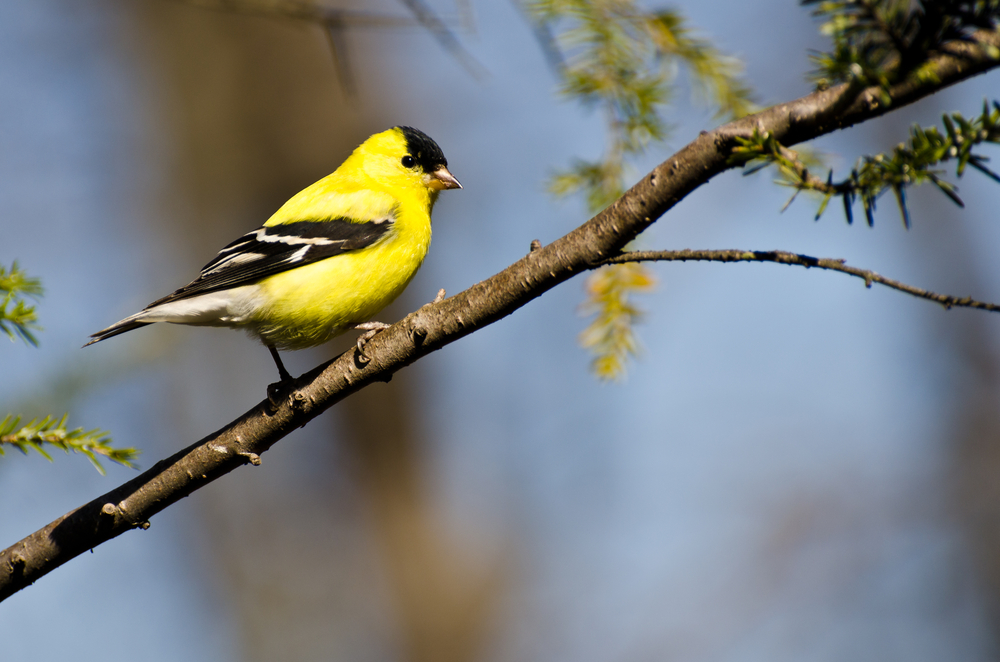
- Species Name: Spinus tristis
- Length: 11 cm to 13 cm
- Weight: 11 grams to 20 grams
- Wingspan: 19 cm to 22 cm
Homebody birdwatchers will love this finch – they’re a popular sight at bird feeders due to their range and feeding habits.
Appearance
Adult males are bright yellow with black wings and white wing bars. However, they will change to a subtle yellow-brown coloration during the winter.
Females are subtle with more brown and gray, though they have yellow on their bellies.
Range
You’ll find these birds just about anywhere in Washington. They usually head west for breeding season, but stick around the eastern portion of the state year-round.
Visit any state park or forest trail and you’ll find these birds digging for food. They’re also regular visitors to backyard bird feeders.
Diet
American goldfinches love to forage for seeds, though they sometimes eat twig bark or insects.
You’ll have no trouble attracting American goldfinches with abundant seeds — black oil sunflower seeds, especially. You can also encourage them to stick around by planting milkweed or thistle around your yard.
Birdsong
Their birdcall repeats a rising and falling pattern of tweeter-tweeter-ree warbles with the occasional trill.
Fun Fact
American goldfinches build such sturdy nests they can even hold water!
Lesser Goldfinch

- Species Name: Spinus psaltria
- Length: 9 cm to 11 cm
- Weight: 8 grams to 11 grams
- Wingspan: 15 cm to 20 cm
With a similar appearance (and a similar scientific name!), lesser goldfinches may look similar to American goldfinches. However, there are a few differences you need to know!
Appearance
While male lesser goldfinches also have similar coloration to American goldfinches, they range from having black backs to gray-brown backs. They’re also significantly smaller.
Female lesser goldfinches have a little yellow on their bellies and olive wings.
Range
Many lesser goldfinches stick around Washington all year long, though they’re much more common during the breeding season. Expect to see them flitting around weedy fields, state parks, and forest clearings.
They’re also a rather common sight in backyards and gardens, especially if you know what to feed them.
Diet
Lesser goldfinches frequently browse willow and alder trees for food (which Washington has in spades). They love a mixture of fruits, fruit buds, nuts, and seeds to round out their diet.
Stock up on nyjer and sunflower seeds to make your backyard simply irresistible.
Birdsong
I can’t get over how cute these birds sound. Their call is simple and airy, composed of a dipping whistle with long pauses in between.
Fun Fact
Lesser goldfinches are quite social birds and often hang with four to six other peers. However, they can sometimes form flocks in the dozens during breeding season.
Cassin’s Finch
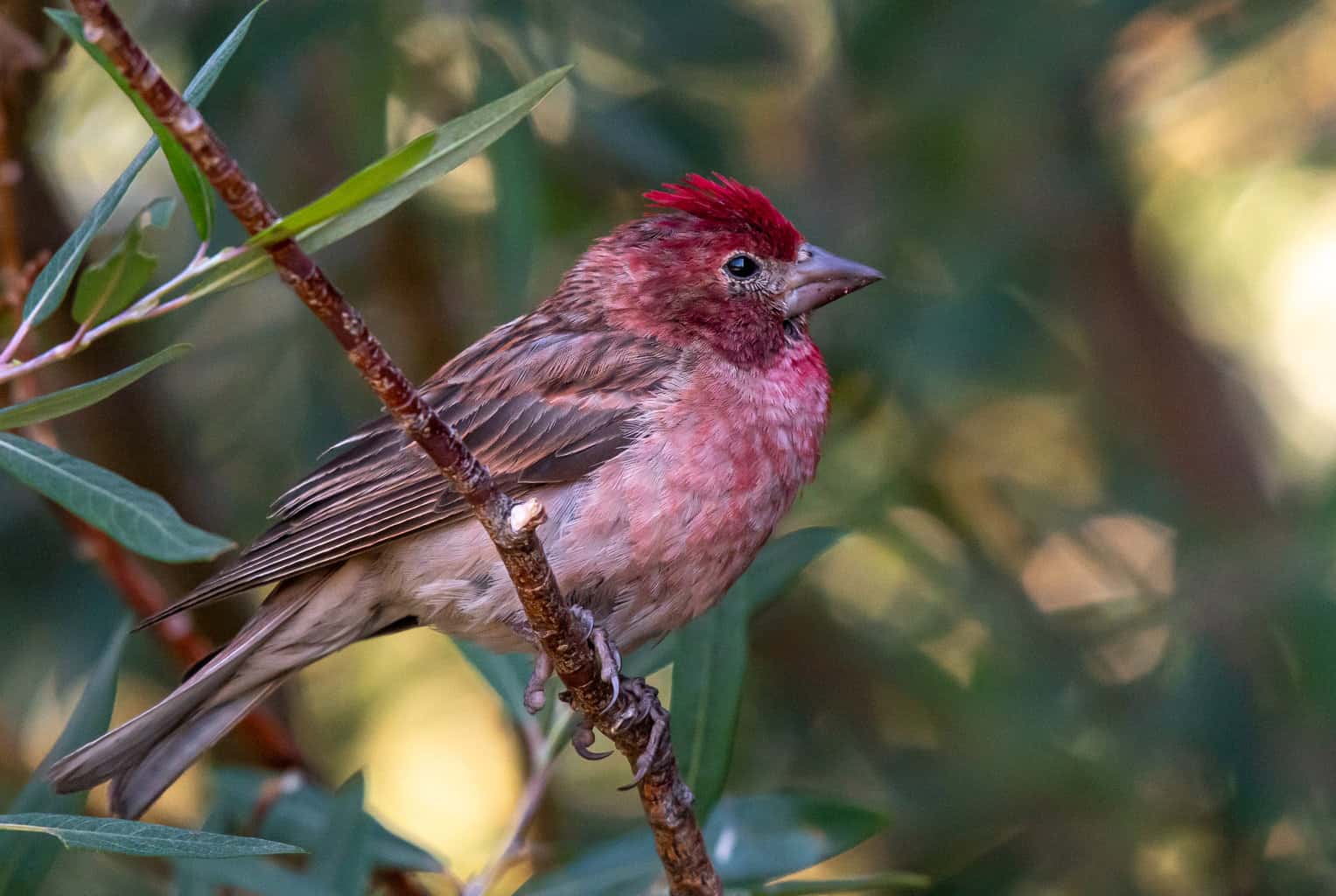
- Species Name: Haemorhous cassinii
- Length: 16 cm
- Weight: 24 grams to 34 grams
- Wingspan: 25 cm to 27 cm
These elegant finches aren’t the easiest to spot, but a little timing and determination go a long way.
Appearance
Male Cassin’s finches have a rustic coloration, boasting brown bodies with reddish-pink heads and chests. Their stomachs are usually a light gray-white, matching their pale gray bills.
The female Cassin’s finches are brown and white with streaked chests, looking similar to juveniles.
Range
If you’re in Washington during the springtime, you’ll find plenty of Cassin’s finches roaming the wild. Their numbers dwindle the rest of the year, but a few will linger in the state’s signature coniferous forests.
Diet
Their diet will shift depending on the season – these birds love seeds in the summer and fruit in the winter. As such, try to attract them to your backyard feeders with sunflower seeds or mulberries, respectively.
Birdsong
This bird has a charming and dynamic warble with long pauses in between.
Fun Fact
While bird’s nests are known for being tough little creations, the Cassin’s finch nest is a little delicate. These finches usually construct theirs with weed stems and thin twigs.
Brambling

- Species Name: Fringilla montifringilla
- Length: 16 cm
- Weight: 23 grams to 29 grams
- Wingspan: 25 cm to 29 cm
As a painter, I’m a big fan of visual contrast. The brambling is a rare and dashing sight since its warm feathers stand out against Washington’s green trees.
Appearance
These beautiful finches have mottled gray and black heads with bold orange chests. Their wings boast streaks of black and white.
Female bramblings have similar coloration but are a little more faded.
Range
Bramblings will be a challenge for even experienced birdwatchers since they’re an accidental species in Washington. However, keep a close eye on forests with willow and birch trees.
They also occasionally show up in parks or backyards, particularly if they have the above trees.
Diet
The brambling has a seasonal diet – they prefer insects in the summer, but forage for seeds when it gets cold.
Birdsong
They have sparse and high-pitched notes, alternating between a chip and a buzzy tweet.
Fun Fact
Want to challenge your eye for detail? The brambling looks very similar to a common chaffinch.
House Finch
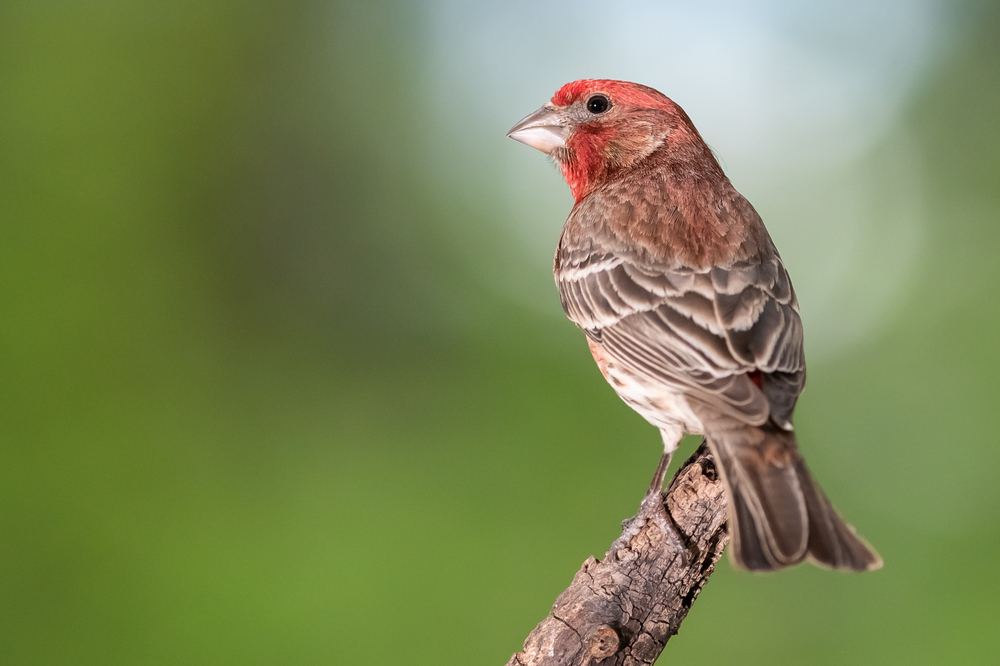
- Species Name: Haemorhous mexicanus
- Length: 13 cm to 14 cm
- Weight: 16 grams to 27 grams
- Wingspan: 20 cm to 25 cm
There’s nothing wrong with wanting to seek out more common birds if you’re on a time limit. The house finch is quite easy to find (and even easier to hear).
Appearance
The male house finch is rather dashing with a light brown body and blushing red head and chest. The female house finch goes for simplicity with a light gray and brown mottled body.
Range
The house finch appears throughout Washington state year-round, though shows up a little more often during the summer. Expect to encounter and hear their chattering flocks in parks, farms, and backyards.
They also are quite fond of bird baths!
Diet
There’s no mystery to the house finch’s diet (and it’s a big reason why they’re so widespread). These birds love seeds, flower buds, and fruit, but sometimes will eat tiny insects called aphids.
Want to attract a few social birds for some backyard viewing? Get yourself a platform feeder and outfit it with millet or black oil sunflower seeds.
Birdsong
The house finch may not seem as bombastic as other finches, but their finch song begs to differ. They warble complex notes composed of chirps, cheeps, and tweets.
Fun Fact
Unlike some finch species, house finches are very comfortable in urban locations. They’re one of the most adaptable birds in the United States.
Common Redpoll

- Species Name: Acanthis flammea
- Length: 12 cm to 14 cm
- Weight: 11 grams to 20 grams
- Wingspan: 19 cm to 22 cm
Washington has a solid four seasons and this bird prefers to show up during the most dramatic one. When you see the common redpoll against a sheet of freshly fallen snow, you’ll never forget it.
Appearance
The male common redpoll has a speckled brown and white body, white breast, and a signature red spot on its forehead. Its beak is a bright orange and a little shorter than other finches.
The female common redpoll also has the red forehead spot, but an entirely brown body with white streaks.
Range
These finches prefer to pop up during the winter season as well as early spring. You’ll have no trouble spotting them as they fly around weedy fields or forage in trees.
Diet
Common redpolls chase after insects during the summer, but stock up on seeds in the winter. They’re also keen on visiting backyard feeders for an easy meal, so stock up on nyjer seeds.
Birdsong
The redpoll song is crisp and short, composed of chit-chit-chit sounds in successions of two or three.
Fun Fact
You don’t have to venture very far to see a common redpoll. These birds often prefer to skirt the edges of forests and fields.
Hoary Redpoll

- Species Name: Acanthis hornemanni
- Length: 12 cm to 14 cm
- Weight: 11 grams to 20 grams
- Wingspan: 22 cm to 23 cm
While the common redpoll is easier to spot, the hoary redpoll is an accidental species in Washington. They’re quite an elegant sight, so bring your best binoculars.
Appearance
The hoary redpoll looks similar to the common redpoll, but much more pale and with less red on the chest. Female hoary redpolls look similar but with more streaks and no red on their chest.
Range
The reason hoary redpolls don’t usually show up in Washington is because they prefer subarctic environments. However, they’ll still sometimes drift toward smaller towns with weedy fields and scrubland.
Diet
Alder seeds, flower buds, and insects are their favorite food. While it’ll be rare to see them at a feeder, they’re attracted to willow and cottongrass seeds.
Birdsong
Their call is an overlapping succession of three-note che-che-che sprinkled with repetitive trills.
Fun Fact
This finch is elegant in more ways than one. Their name includes the Greek name akanthis – this is similar to acanthus, an ornamental decoration often seen in pottery and sculpture.
White-Winged Crossbill
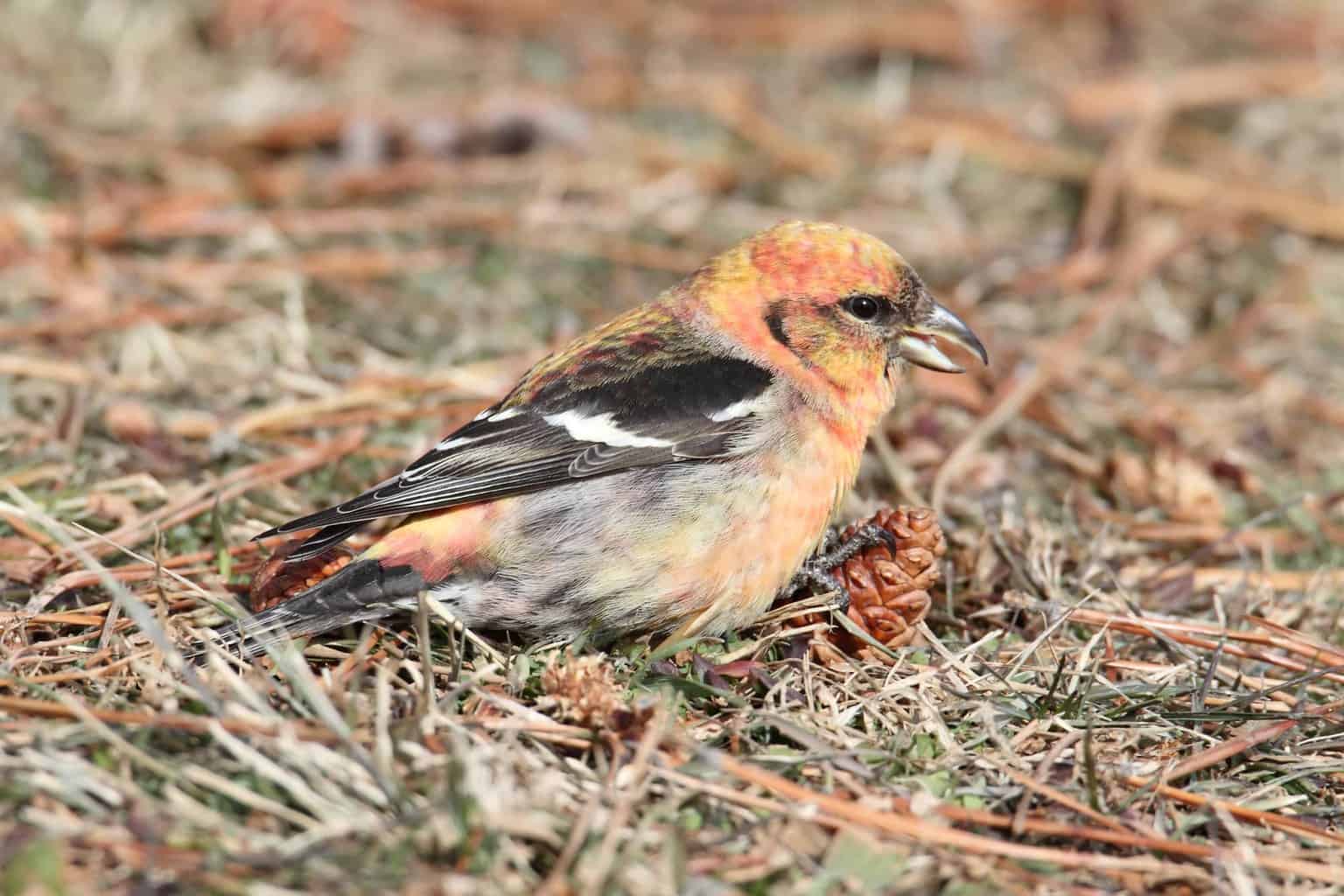
- Species Name: Loxia leucoptera
- Length: 15 cm to 17 cm
- Weight: 24 grams to 26 grams
- Wingspan: 26 cm to 28 cm
When you want a bold bird for your photography portfolio, you can’t go wrong with the white-winged crossbill. They have both the feathers and the diversity of beak shapes to match!
Appearance
The male white-winged crossbill earned its name because of the unique ways its powerful beak ‘criss-cross’ when closed. Their feathers are a brilliant, deep red with black wings and white wing bars.
Female white-winged crossbills have soft yellow-green bodies with similar black wings and white wing bars.
Range
While white-winged crossbills aren’t super common in my state, they will show up no matter the season. They’re very fond of spruce forests where they can dive into cones and dig out seeds.
Diet
Spruce cones and conifer cones are their go-to diet, often spending hours roaming trees and tugging out delicious seeds. However, they sometimes eat sunflower seeds, so stock up your feeder!
Birdsong
The crossbill song is as powerful as its appearance, a nearly unbroken string of repetitive chr-chr-chr and trills.
Fun Fact
The reason their bills are crossed is so they can better squeeze through the gaps of pinecones to get their favorite food.
Pine Siskin

- Species Name: Spinus Pinus
- Length: 11 cm to 14 cm
- Weight: 12 grams to 18 grams
- Wingspan: 18 cm to 22 cm
Another prime choice for the beginning birdwatcher is the omnipresent pine siskin. This finch loves Washington as much as I do and shows up year-round!
Appearance
The male pine siskin looks like dappled sunlight come to life – their bodies are a medley of soft yellows streaked with light brown. You can also see a hint of yellow on their wings.
Female pine siskins are more subtle, usually having brown and white speckles all over. However, they may occasionally have a dusting of yellow on their wings.
Range
You’ll see pine siskins foraging for their main source of food in forests, dangling upside down from pine cones all throughout the year. Keep an eye on thick pine forests or heavily forested park areas.
Diet
These finches are one of the easier species to attract to a bird feeder. Stock up on fresh black oil sunflower seeds and nyjer seeds.
Despite their primary food source, they may be more likely to show up during winter months if you get a suet feeder.
Birdsong
The pine siskin is an excitable-sounding bird, having a long, buzzing tweee occasionally broken up by brief tweets. They will also make the occasional ‘chattering’ sound.
Fun Fact
Pine siskins are charming birds to watch or paint, but they can be a little territorial around other bird species. Their ability to feed upside down makes them quite adaptable to any feeding situation, much to the chagrin of other birds!
Pine Grosbeak
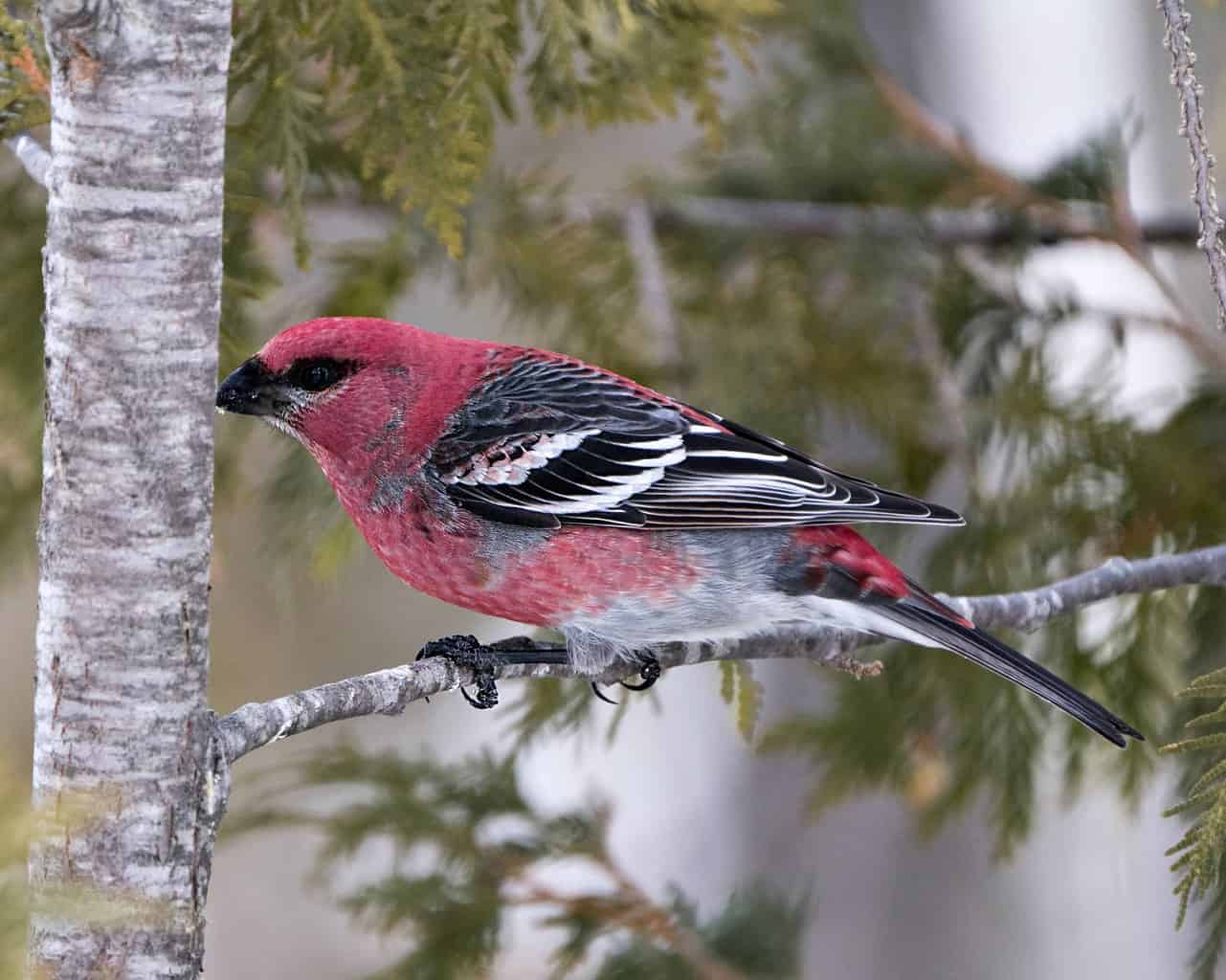
- Species Name: Pinicola enucleator
- Length: 20 cm to 25 cm
- Weight: 57 grams
- Wingspan: 33 cm
This rather striking finch crops up occasionally in Washington, so jot it down on your list so you don’t forget!
Appearance
The male pine grosbeak has striking red coloration with gray wings, a gray tail, and streaks of white on its wings. They also have a distinctive forked tail.
Female pine grosbeaks have grayer bodies with dustings of orange on their heads and lower back.
Range
If you ever feel like hiking through one of Washington’s many lovely mountains, keep an eye out. Pine grosbeaks are comfortable in forested and mountainous areas, though they sometimes go into urban areas to check out bird feeders.
Diet
Flower buds, seeds, and fruit are the preferred foods of choice. If you want to attract a few pine grosbeaks to your feeder, stock up on black oil sunflower seeds.
These beautiful birds are also quite fond of suet to stay warm. Keep it around as a consistent food source in your backyard during winter.
Birdsong
They have a sweet, lilting birdsong composed of short, repetitive warbles. These often come in notes of three in a rise-fall-rise pattern.
Fun Fact
While adult pine grosbeaks eat quite a bit of vegetable matter, this food is hard for their chicks to digest. They usually feed their chicks insects and spiders to compensate.
Gray-Crowned Rosy Finch

- Species Name: Leucosticte tephrocotis
- Length: 14 cm to 21 cm
- Weight: 22 grams to 60 grams
- Wingspan: 33 cm
These medium-sized finches are a little underrated due to their subtle coloration. It’s this very reason they’re a favorite of mine, because how often do you see birds with these colors?
Appearance
The male gray-crowned rosy finch has an interesting blend of a brown body flecked with rosy pink. Their heads are gray and lead into a dark gray or black throat.
Female gray-crowned rosy finches lean toward the gray and brown end of the spectrum with less pink.
Range
This finch is a rather unpredictable one, preferring to show up in Washington sporadically during the summer and fall. They’re not very common, but try to spot them in fields, valleys, and small towns.
Thankfully, this bird is also fond of feeders!
Diet
You’ll increase your chances of luring a few of these beauties to your backyard with mustard seeds and black oil sunflower seeds.
Birdsong
These plump finches are chatty, having a rambling and twittering warble mixed with a few chut-chuts.
Fun Fact
While the male gray-crowned rosy finch has a black conical beak during mating season, it turns yellow during the winter.
Lawrence’s Goldfinch

- Species Name: Spinus lawrencei
- Length: 10 cm to 12 cm
- Weight: 9 grams to 14 grams
- Wingspan: 21 cm
These fascinating finches are a rare sight in Washington, but have a rather specific foraging habit that can increase your chances.
Appearance
Males are immediately distinguishable for their gray bodies and streaked yellow and black wings. They have a black head with black streaks over their eyes.
Females are rather similar at a glance but lean toward the paler end of the spectrum.
Range
These beautiful birds are fond of woodlands, but even fonder of bodies of water. Try to see if you can catch them near brooks, rivers, or lakes.
You might also spot a few of Washington’s many duck species while you’re at it!
Diet
While the Lawrence’s Goldfinch occasionally eats insects, they much prefer seeds.
Birdsong
This goldfinch song is one of the most dynamic of all the finches, characterized by twittering, chirps, trills, and squeaky chweet-chweets.
Fun Fact
These birds are an accidental species in Washington state, unlike many of the other finches on this list.
Evening Grosbeak

- Species Name: Hesperiphona vespertina
- Length: 16 cm to 22 cm
- Weight: 38 grams to 86 grams
- Wingspan: 30 to 36 cm
These finches are rather dynamic in their range, showing up here and there all over Washington state.
Appearance
Male evening grosbeaks have golden yellow bodies, black heads, and a pop of white on their wings. They frequently sport a yellow brow line that makes them look a little grouchy.
Female evening grosbeaks are predominantly gray with the same black and white wings as the males. They sometimes have a faint dusting of yellow on their neck or throat.
Range
These birds are great for winter checklists if you live in the southeast. They also appear in northern Washington during the breeding season.
They’re big fans of mountains and forests but may visit your bird feeder if you have a little incentive…
Diet
These are the types of finches to eat almost anything – fruit, seeds, berries, insects, you name it! Try outfitting a platform feeder with black oil sunflower seeds to bring them over.
Birdsong
Evening grosbeaks have an interesting call that almost sounds like breathing very quickly. Expect to hear fast in-and-out trills broken up by bright chirps and chips.
Fun Fact
Evening grosbeaks can crop up in flocks of up to a hundred.
Red Crossbill

- Species Name: Loxia curvirostra
- Length: 14 cm to 17 cm
- Weight: 40 grams
- Wingspan: 25 cm to 27 cm
Last but not least, we have the dazzling red crossbill to make your Washington journey unforgettable. While a little on the rare side, you can see them year-round.
Appearance
Males have vivid red bodies with dark wings and tails. Their dark beaks will cross when closed.
Females are simpler in appearance with light brown and yellow bodies.
Range
These finches love coniferous forests and will spend quite a bit of time cracking open pinecones.
Diet
While this bird loves to eat pine seeds, it also has a weakness for salt. You can also try attracting them to your bird feeder with traditional suet or millet.
Birdsong
These finches have a lovely song, alternating between warbling two-notes and dainty chirps.
Fun Fact
Recent research has found variations in red crossbills might be different species entirely.
Birdwatching and Washington State Is a Match Made in Heaven
When you’ve got a state overflowing with carefully protected forests and mountains, you won’t have to look hard to spot finches. Washington state is a real treasure for passionate bird watchers and beginning hobbyists alike.
When heading out on an expedition, I highly recommend getting the best of both worlds. Go on a nature hike or visit one of the national parks for your next birdwatching trip.
Not only will you witness these birds in their natural habitat, you’ll enjoy some lovely scenery, too!
If you want to learn more about the wildlife here, check out our guide on birds in Washington.

